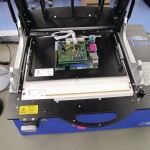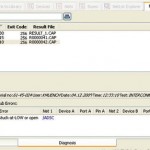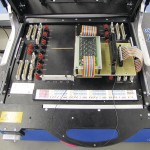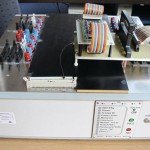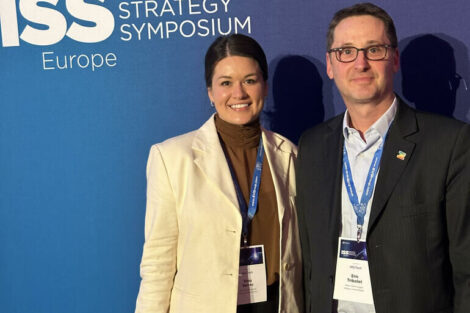Every car driver has had experiences with parking systems, petrol station systems or fare collection systems. But their developer and producer is not well known. The company Scheidt & Bachmann (S&B) has existed since 1872 – today in the fifth generation. Currently, the company headquartered in Moenchengladbach/Germany has approx. 2,000 employees, 24 subsidiaries and about 50 partners worldwide. In four virtually independent business units, systems for parking and leisure facilities, signalling equipment, fare collection management and petrol stations are developed, produced and distributed.
Goepel electronic, Jena (Germany) & Scheidt & Bachmann, Moenchengladbach (Germany)
Scheidt & Bachmann systematically pursues its strengths and introduces innovative processes. One of the reasons why the company is a market leader in all product ranges – both in Europe and worldwide. But how do you become market leader in these segments? Primarily, because of qualified employees, highly developed production technologies and associated high quality, which is the main reason for the company’s product success.
Requirements for efficient quality assurance
Quality assurance has always been a critical demand constantly upheld by the company’s test engineers. In particular, the reliable functionality of the used electronic assemblies puts high requirements on the test technologies used.
Traditionally, “classic” test methods, such as In-Circuit Test (ICT) was applied. However, for some time there have been test access problems because of increasing board complexity, accompanied by high costs for bed-of-nails test fixtures to be used. That’s why boundary scan technology was given a closer look, and finally utilized. The selected boundary scan system had served well for many years, however there was still potential for improvement in fault localization and elaborate programming (without model library), exclusively executed by the designers. This and the fact that new standards would have caused a completely new purchase of hardware caused the company test experts to put out their feelers for alternatives.
At the “Best-of-Processing” symposium in Moenchengladbach/Germany in 2008, contact with the test and measurement vendor Goepel electronic was strengthened. Goepel electronic was already well-known to the company’s engineers as a technologically leading provider of boundary scan solutions. Experts from Goepel electronic were invited to the S&B headquarters to discuss the objective target to create a future-oriented test strategy intended to run for ten years. The actual state was analysed and the detailed ideas with regard to quality assurance were defined.
A central requirement for the new test concept was the necessity to completely integrate a boundary scan solution into the “Scheidt & Bachmann world”. This primarily related to the data flow that must be executed fully automatically via direct database access, a comparable operability similar to the previously utilized ICT as well as fault visualization in the PCB layout to enable a fast fault localization for everyone. An add-on wish was to “put the test field in the position to independently maintain and extend test programs without calling the development departments”, says Andreas Schemura, test development engi-neer with Scheidt & Bachmann. “We were sure in one point: Boundary scan is the right way for the next ten years.”
One of the demands on the boundary scan test system has developed over the course of the project stage: originally, the first concept version included an autarchic boundary scan test station. But there were assemblies featuring such a multitude of connectors that contacting would have meant an enormous test time ranging into minutes. Consequently, the target was a fast adaptation of all connectors. Up to then it took two minutes to contact all connectors on the board to execute a test that takes a few seconds. In the case of fault occurrence and detection, all connectors needed to be uncoupled and reconnected after fault elimination, which again meant a tremendous time effort.
The “hybrid solution” Juliet
Goepel electronic’s proper solution to this problem was the introduction of the boundary scan production test system Juliet presented in the spring of 2009, and later honoured with the “best in test award 2010” of the global magazine “Test & Measurement World”. The desktop system’s concept exactly met the requirements S&B had for a test system. The system combines the entire boundary scan test electronics incl. add-on modules for analogue test as well as the basic mechanics in a compact system, and provides a defined interface to exchangeable adaptors.
In addition to the fast contact opportunities, Juliet’s advantage is the similar operability as compared to an in-circuit tester the test department’s personnel has been familiar with for many years. “Very fast we recognized that Juliet was exactly the right so-lution”, says Andreas Schemura.
The proper solution was found soon. Now the specific software requirements needed for inclusion into the existing infrastructure needed to be met. A requirement specification was drawn up especially focusing on a uniform and fully automatic data flow. For example, the infrastructure had to contain repair data, and operation faults had to be minimized by an appropriate process locking. Moreover, it was important to ensure that the test program was used with the current firmware version, which is critical during the application of FPGA based solutions. Additional basic requirements were the acquisition, reception and registration of on-off data, e.g. a MAC address from the data server.
A test run in practice
A test process starts with creating an order sheet incl. UUT description and approved serial number. The test engineer places the board in the Juliet system, scans the barcode, and the software checks if the barcode relates to the order. If all necessary data are available – in the case of a new order they possibly need to be retrieved from the server – the test process is started and evaluated. An error log is generated automatically and sent to the MES (Manufacturing Execution System). Finally, the diagnostic file is displayed in ScanVisionIII, the layout viewer in Goepel electronic’s system software System Cascon. System Cascon enables the implementation of a pure repair station. In this case, a list including all serial numbers that have been checked as well as test results (PASS/FAIL) is generated. After selecting the respective assembly all occurred faults are displayed, subsequently to be fixed. Of course, there is a protocol about all processes for later monitoring.
The implementation of a project or requirements for a test system has been successfully executed in close cooperation between the two companies. This tight collaboration even resulted in new products: since a bed-of-nails fixture is not worth purchasing for low batches, Juliet’s usability without contacting equipment was discussed. The idea of utilizing a so called universal adapter arose. Hereby, the Juliet system’s entire pin interface is provided on the upper part of the adapter in the form of connectors. The UUT is finally placed on the universal adapter and connected with UUT-specific wires. Hence, the UUT is wired “in classic terms”, and the Juliet based system can be operated in the familiar mode.
After a repeated exchange of ideas Scheidt & Bachmann’s test equipment builders developed a ‘Juliet without Juliet’, i.e. the tester’s entire inner workings were integrated in a 19 inch housing providing the same controls. The upper side of this solution looks like the universal adapter of the “real” Juliet. All cables developed during test program generation can be further applied in production.
Therefore, development and test department both have a nearly identical system in terms of functionality and program compatibility. “Interfaces and operating unit are fully compatible with Juliet − due to the work of Scheidt & Bachmann”, says Mario Berger, Sales Engineer with Goepel electronic GmbH.
Summary
The project “test strategy and equipment for the next ten years” has been an ambitious goal, stepwise but purposefully approached in tight collaboration by both partners throughout several months. Both parties did benefit in the development. After project completion it could be stated that the full integration of the Juliet test system into the “Scheidt & Bachmann world” succeeded. The system enjoys a high acceptability among the test personnel since introduction, enabling time and cost reductions. At the moment, 12 bed-of-nails projects and ten universal adapter projects are utilized. The test field is able to extend and maintain programs without the help of the development department. Fault localization is very easy and the data flow is fully automated, which almost completely excludes operating errors. Andreas Schemura concludes: “The cooperation with Goepel electronic was not only successful but highly enjoyable. We collaborate with competent experts in terms of project planning, project preparation as well as support. For us, Goepel electronic is a reliable partner, having met our expectations to our fullest satisfaction.”
Electronica, booth A1.351
Zusammenfassung
Juliet vereint die gesamte Boundary-Scan-Testelektronik inklusive Erweiterungskarten für analoge Tests sowie die Grundmechanik in einem kompakten Gerät und verfügt über ein definiertes Interface für Wechselkassetten, was u. a. zu schnellen Kontaktierungsmöglichkeiten führt.
Juliet réunit l’électronique Boundary Scan et les cartes d’extension pour les tests analogiques ainsi que la mécanique de base dans un appareil compact et dispose d’une interface définie de cassettes de remplacement, permettant ainsi, entre autres, des connexions rapides.
Share:



